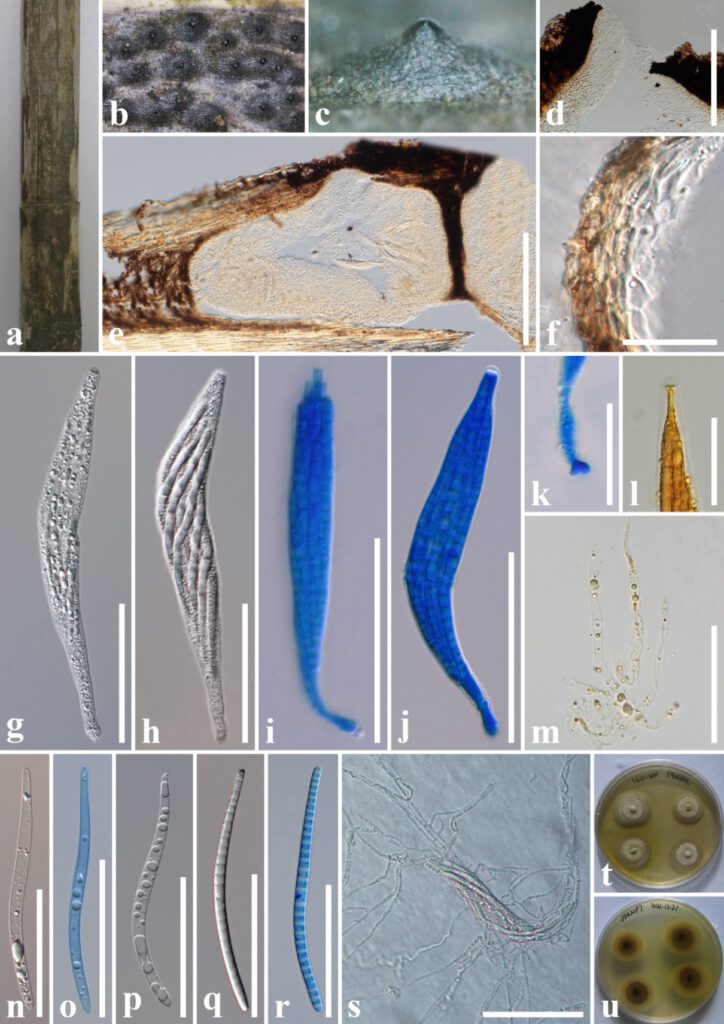Linocarpon bambusina X. Zhang & Tibpromma, in Zhang, Dai, Du, Karunarathna & Tibpromma, Phytotaxa 584(2): 95 (2023)
Index Fungorum number: IF 662570; MycoBank number: MB 662570; Facesoffungi number: FoF 12953;
Holotype – GMB1360
Etymology – Species epithet refers to the host genus “bambusa” from which the holotype was isolated.
Saprobic on dead culms of bamboo. Sexual morph: Ascomata 150–330 × 360–560 μm (x̄ = 223.5 × 484 μm, n = 10), solitary or aggregated, mostly aggregated, semi-immersed, comprising black, shiny, dome-shaped, raised, flattened at the base, central ostiole with papillate. Peridium 15–50 μm wide (x̄ = 32 μm, n = 10), outer cells merging with the host epidermal cells, composed of brown to dark brown cells of textura angularis. Hamathecium 2.5–6 µm wide (x̄ = 4.1 μm, n = 20), hyaline, hypha-like, septate paraphyses, longer than asci. Asci 75–140 × 9–20 μm (x̄ = 105 × 12.3 μm, n = 34), 8-spored, unitunicate, fusiform, short pedicellate, some club-shape like, with a J- subapical ring. Ascospores 65–100 × 2–6 μm (x̄ = 87.4 × 4.6 μm, n = 42), biseriate or partially uniseriate, filiform, straight or curved, hyaline, 28–30 septa, parallel when immature, becoming spiral when mature, guttules, ends slightly rounded, without appendage or mucilaginous sheath, smooth-walled. Asexual morph: Undetermined.
Culture characteristics – Ascospores germinated on PDA within 24 h, and pure mycelia after one month cultured at 25–28 ℃, circular, flossy, umbonate, curled, white to pale brown in above, the reverse side is brown in the middle and yellow-white at the margin.
Material examined – China, Yunnan Province, Lijiang City, on dead culms of bamboo, 13 July 2021, D. Q. Dai, DDQ02097 (holotype, GMB1360; ex-type living cultures, GMBCC1155).
Notes – In the phylogenetic tree, our new species Linocarpon bambusina formed a well-separated clade basal to L. pandanicola (HKUCC3783, HKUCC 4385, HKUM16280) with moderate bootstrap support (55% ML) (Fig. 1). The comparison of LSU nucleotides between our taxon and L. pandanicola (HKUCC 4385) resulted in 8.1% difference (65/800 bp), but L. pandanicolaL. bambusina. In the morphological study, L. bambusina can be distinguished from L. pandanicola by having shiny ascomata, ostiolar papillate, asci fusiform and club shape, ascospores with 28–30 septa, and no appendages or mucilaginous sheath, while these characteristics are not present in L. pandanicola. In addition, our taxon and L. arengae are similar in asci pedicellate with a J- subapical ring, and filiform ascospores with straight or curved. However, L. bambusina can be distinguished by having semi-immersed ascomata, fusiform asci, ascospores with 28–30 septa, not constricted at septa, guttules, and no appendages or mucilaginous sheath, while L. arengae has immersed ascomata, cylindrical asci, aseptate ascospores, containing numerous refringent septum-like bands, with polar mucilaginous appendage at the apex (Konta et al. 2017). In addition, our new species is distinguished morphologically by its relatively semi-immersed ascomata, and 28–30-septate ascospores, which is different from other species in Linocarpon. Therefore, we introduce L. bambusina as a new species based on morphological and multigene phylogenetic analyses.

FIGURE 2. Linocarpon bambusina (GMB1360, holotype) a–c. Appearance of ascomata on host substrate. d. Section of an ostiole. e. Section of an ascoma. f. Peridium. g–j. Asci (i, j stained by Cotton blue reagent). k. Club shape pedicel stained by cotton blue reagent. l. Ascus apical tip stained by cotton blue reagent. m. Paraphyses. n–r. Ascospores (o, r stained by cotton blue reagent). s. A germinating ascus. t, u. Colonies on PDA from above and below after one month. Scale bars: d, e = 200 μm; f, k = 20 μm; g-j = 50 μm; l, m = 20 μm; n-s = 50 μm.
